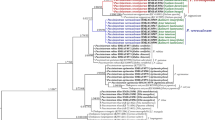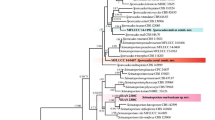Abstract
White blister rust of sunflower is an emerging disease that is among the most important diseases in this crop in South Africa and has recently spread to Europe. For the genus Albugo, it has been demonstrated that species are mostly at least host genus specific and that several previously overlooked species are present on Brassicaceae. It thus seems likely that previously unrecognised species are also present in the genus Pustula. Based on previous phylogenetic reconstruction in combination with differences in oospore ornamentation, it is revealed that Pustula on sunflower, previously attributed to Pustula tragopogonis (syn. Albugo tragopogonis), is distinct from Pustula on Tragopogon. Therefore, this pathogen is described as a new species, Pustula helianthicola. In addition, taxonomic observations revealed that Pustula tragopogonis is an incorrect name and is replaced by the new combination, Pustula obtusata.

Similar content being viewed by others
References
Allen SJ, Brown JF (1980) White blister, petiole greying and defoliation of sunflowers caused by Albugo Tragopogonis. Australas Plant Pathol 9:8–9
Baker SD (1955) The Genus Albugo in New Zealand. Trans R Soc N Z 82:987–993
Bandounas-van den Bout T (2005) White rust (Albugo tragopogonis) of sunflower in South Africa. URN etd-05232005-121025, University of Pretoria
Belbahri L, Calmin G, Pawlowski J, Lefort F (2005) Phylogenetic analysis and Real Time PCR detection of a presumably undescribed Peronospora species on sweet basil and sage. Mycol Res 109:1276–1287
Berglund DR (2007) Sunflower Production. NDSU Extension Service Publication A-1331 (EB-25 revised), North Dakota State University, Fargo
Biga MLB (1955) Riesaminazione delle specie del genere Albugo in base alla morfologia dei conidi. Sydowia 9:339–358
Bremer H, Petrak F (1947) Neue Kleinpilze aus der Türkei. Sydowia 1:248–263
Choi Y-J, Hong S-B, Shin H-D (2006) Genetic diversity within the Albugo candida complex (Peronosporales, Oomycota) inferred from phylogenetic analysis of ITS rDNA and COX2 mtDNA sequences. Mol Phylogenet Evol 40:400–409
Choi Y-J, Shin H-D, Hong S-B, Thines M (2007) Morphological and molecular discrimination among Albugo candida materials infecting Capsella bursa-pastoris world-wide. Fungal Divers 27:11–34
Choi Y-J, Shin H-D, Ploch S, Thines M (2008) Evidence for uncharted biodiversity in the Albugo candida complex, with the description of a new species. Mycol Res 112:1327–1334
Constantinescu O, Thines M (2006) Dimorphism of sporangia in Albuginaceae (Chromista, Peronosporomycetes). Sydowia 58:178–190
Cooke DEL, Drenth A, Duncan JM, Wagels G, Brasier CM (2000) A molecular phylogeny of Phytophthora and related Oomycetes. Fungal Genet Biol 30:17–32
Crepel C, Inghelbrecht S, Bobev SG (2006) First report of white rust caused by Albugo tragopogonis on Sunflower in Belgium. Plant Dis 90:379
Dick MW (2001) Straminipilous Fungi: Systematics of the Peronosporomycetes including accounts of the Marine Straminipilous Protists, the Plasmodiophorids and similar Organisms. Kluwe, Dordrecht
Fálico L, Visintín G, Alcaraz ME (2005) Síntomas producidos por Albugo Tragopogonis en girasoles de Entre Ríos (Argentina). Cienc Docencia Tecnol 16:217–227
Franke W (1997) Nutzpflanzenkunde: nutzbare Gewächse der gemäßigten Breiten, Subtropen und Tropen. Thieme, Stuttgart
Gmelin JF (1792) Systema Naturae 2 (2), Editio Decima Tertia. Leipzig
Gray SF (1821) A natural arrangement of British plants 1. London
Gulya TJ, Viranyi F, Appel J, Jardine D, Schwartz HF, Meyer R (2002) First report of Albugo tragopogonis on cultivated sunflower in North America. Plant Dis 86:559
Hansford CG (1954) Australian fungi. II. New records and revisions. Proc Linn Soc NSW 79:97–141
Kajornchaiyakul P, Brown JF (1976) The infection process and factors affecting infection of sunflower by Albugo tragopogi. Trans Br Mycol Soc 66:91–95
de Lamarck JB, de Candolle AP (1805) Flore Française 2, Troisième Édition. Paris
Landa BB, Montes-Borrego M, Muñoz-Ledesma FJ, Jiménez-Díaz RM (2007) Phylogenetic Analysis of Downy Mildew Pathogens of Opium Poppy and PCR-Based In Planta and Seed Detection of Peronospora arborescens. Phytopathol 97:1380–1390
Link HF (1809) Observationes in Ordines plantarum naturales. Ges Naturforschender Freunde Berl Mag neuesten Entdeck ges Naturkunde 3:3–42
McNeill J et al. (eds) (2006) International Code of Botanical Nomenclature (Vienna Code). Regnum Vegetabile 146. Gantner, Konigstein
Novotelnova NS (1966) Forma specialis nova Cystopodis tragopogonis Schroet. Nov Sist Nizšich Rast 3:126–128
Penaud A, Perny A (1995) La rouille blanche du tournesol. Phytoma Def Végétaux 471:43–45
Persoon CH (1797) Tentamen dispositionis methodicae Fungorum. Leipzig
Persoon CH (1801) Synopsis methodica Fungorum 1. Göttingen
Petersen AB, Rosendahl S (2000) Phylogeny of the Peronosporomycetes (Oomycota) based on partial sequences of the large ribosomal subunit (LSU rDNA). Mycol Res 104:1295–1303
Petkowski JE, Cunnington JH, Minchinton EJ, Cahill DM (2010) Molecular phylogenetic relationships between Albugo candida collections on the Brassicaceae in Australia. Plant Pathol 59:282–288
Petrak F (1955) Neue Mikromyzeten der australischen Flora. Sydowia 9:559–570
Ploch S, Choi Y-J, Rost C, Shin H-D, Schilling E, Thines M (2010) Evolution of diversity in Albugo is driven by high host specifity and multiple speciation events on closely related Brassicaceae. Mol Phylogenet Evol 57:812–820
Ploch S, Telle S, Choi Y-J, Cunnington J, Priest M, Rost C, Shin H-D, Thines M (2011) The molecular phylogeny of the white blister rust genus Pustula reveals a case of underestimated biodiversity with several undescribed species on ornamentals and crop plants. Fungal Biol, in press
Pound GS, Williams PH (1963) Biological races of Albugo candida. Phytopathol 53:1146–1149
Rabenhorst GL (1862) Fungi Europaei Exsiccati, Klotzschii herbarii vivi mycologici continuatio, Editio nova. Cent. V, Dresden
Riethmüller A, Voglmayr H, Göker M, Weiß M, Oberwinkler F (2002) Phylogenetic relationships of the downy mildews (Peronosporales) and related groups based on nuclear large subunit ribosomal DNA sequences. Mycologia 94:834–849
Ronco L, Rollán C, Choi Y-J, Shin H-D (2009) Downy mildew of sweet basil (Ocimum basilicum) caused by Peronospora sp. in Argentina. Plant Pathol 58:395
de Roussel HFA (1806) Flore du Calvados et des terreins adjacens. IIe Edition, Caen
Spegazzini C (1889) Fungi Puiggariani Pugillus I. Bol Acad Nac Cienc Córdoba 11:381–622
Swingle WT (1892) Some Peronosporaceae in the herbarium of the Division of Vegetable Pathology. J Mycol 7:109–130
Thines M, Spring O (2005) A revision of Albugo (Chromista, Peronosporomycetes). Mycotaxon 92:443–458
Thines M, Zipper R, Schäuffele D, Spring O (2006) Characteristics of Pustula tragopogonis (syn. Albugo tragopogonis) newly occurring on cultivated sunflower in Germany. J Phytopathol 154:88–92
Thines M, Choi Y-J, Kemen E, Ploch S, Holub EB, Shin H-D, Jones JDG (2009a) A new species of Albugo parasitic to Arabidopsis thaliana reveals new evolutionary patterns in white blister rusts (Albuginaceae). Persoonia 22:123–128
Thines M, Telle S, Ploch S, Runge F (2009b) Identity of the downy mildew pathogens of basil, coleus, and sage with implications for quarantine measures. Mycol Res 113:532–540
Timme RE, Simpson BB, Linder CR (2007) High-resolution phylogeny for Helianthus (Asteraceae) using the 18 S-26 S ribosomal DNA external transcribed spacer. Am J Bot 94:1837–1852
Voglmayr H, Riethmüller A (2006) Phylogenetic relationships of Albugo species (white blister rusts) based on LSU rDNA sequence and oospore data. Mycol Res 110:75–85
Walker J, Priest MJ (2007) A new species of Albugo on Pterostylis (Orchidaceae) from Australia: confirmation of the genus Albugo on a monocotyledonous host. Australas Plant Pathol 36:181–185
Whipps JM, Cooke RC (1978a) Nomenclature of Albugo tragopogonis (Pers.) S. F. Gray. Trans Br Mycol Soc 70:285–287
Whipps JM, Cooke RC (1978b) Behaviour of zoosporangia and zoospores of Albugo tragopogonis in relation to infection of Senecio squalidus. Trans Br Mycol Soc 71:121–127
Wilson GW (1907) Studies in North American Peronosporales - I. The genus Albugo. Bull Torrey Bot Club 34:61–84
Yerkes WD, Shaw CG (1959) Taxonomy of the Peronospora species on Cruciferae and Chenopodiaceae. Phytopathology 49:499–507
Acknowledgements
M.T. designed the study, C.H.R. performed microscopic investigations and analyses including photographs and drawings, while M.T. and C.H.R. carried out the taxonomic analyses and wrote the manuscript. We are indebted to the curators of the Herbaria DAR and VPRI for the kind loan of herbarium specimens in their keeping, and to the curators of G and L for allowing access to the specimens of A.P. De Candolle and H. Persoon, respectively. This study was supported by grants from the Elite Program for Postdocs of the Landesstiftung Baden-Württemberg, awarded to M.T. The present study was financially supported by the research funding programme "LOEWE - Landes-Offensive zur Entwicklung Wissenschaftlich-ökonomischer Exzellenz" of Hesse's Ministry of Higher Education, Research, and the Arts.
Author information
Authors and Affiliations
Corresponding author
Rights and permissions
About this article
Cite this article
Rost, C., Thines, M. A new species of Pustula (Oomycetes, Albuginales) is the causal agent of sunflower white rust. Mycol Progress 11, 351–359 (2012). https://doi.org/10.1007/s11557-011-0748-z
Received:
Accepted:
Published:
Issue Date:
DOI: https://doi.org/10.1007/s11557-011-0748-z




